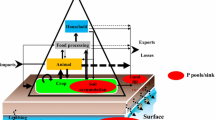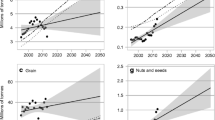Abstract
The changes in the food supply over a period of almost 50 years in the three biggest economies in Asia were examined to estimate the change in the virtual phosphorus requirements in each country over time with regard to food consumption. While the overall food supply in the rapidly growing economies of India and China grew rapidly, there are some remarkable differences in the food supply in these two emerging giant economies over time. Having undergone rapid development in the late 1970s and 1980s, Japan’s food supply stabilized with the stagnation of the Japanese economy in the mid 1990s. The implications of the changes in the food supply of these three economies are discussed in terms of the phosphorus demand for producing food for these three countries using the concept of the virtual phosphorus. Future projections were made to create a likely case scenario for the virtual phosphorus requirements in these countries in the lead up to 2050 by extrapolation and by incorporating the latest population predictions.






Similar content being viewed by others
References
Abelson PH (1999) A potential phosphate crisis. Science 283:2015
Andersson K, Ohlsson T (1999). Int J Life Cycle Assess 1:25–40
Bruno IP, Unkovich MJ, Bortolotto RP, Bacchi OOS, Neto DD, Reichardt K (2011). Field Crops Res 124: 369–377
Cassman KG (1999) Ecological intensification of cereal production systems: yield potential, soil quality, and precision agriculture. Proc Natl Acad Sci USA 96:5952–5959
Christen K (2007) Closing the phosphorus loop. Environ Sci Technol 41:2078
Cordell D, et al. (2009) The story of phosphorus: global food security and food for thought. Global Environ Change 19ii
Cordell D, Neset T-SS (2013) Phosphorus vulnerability: a qualitative framework for assessing the vulnerability of national and regional food systems to the multi-dimensional stressors of phosphorus scarcity. Global Environ Change. doi:10.1016/j.gloenvcha.2013.11.005
Elser J, Bennett E (2011) Phosphorus cycle: a broken biogeochemical cycle. Nature 478:29–31
FAO (2011) http://www.fao.org/docs/eims/upload/276937/MP3_GCARD.pdf
Fisheries Agency (2013) Fishery statistics. http://www.jfa.maff.go.jp/j/kikaku/toukei/index.html. Accessed 1 Feb 2013
Galloway JN, Townsend AR, Erisman JW, Bekunda M, Cai Z, Freney JR, Martinelli LA, Seitzinger SP, Sutton MA (2008) Transformation of the nitrogen cycle: recent trends, questions, and potential solutions. Science 320(5878):889–892
Gerbens-Leenes PW (2010) Food consumption patterns and economic growth. Increasing affliuence and the use of natural resources. Appetite 55(3):597–608
Gil, Jose M (1995) Food consumption and economic development in the European Union. Eur Rev Agric Econ 22 iii:385–399
Halada K, Ijima K, Katagiri N, Okura T (2001) An approximate estimation of total material requirement of metals. J Jpn Inst Met 65:564–570
Hansen JS, APV Dairy Technology (2011) http://ja.scribd.com/doc/49905875/APV-Dairy-Technology-01-2003. Accessed 1 Feb 2011
Hertwich EG, Glen P. Peters (2009) Carbon footprint of nations: a global, trade-linked analysis. Environ Sci Technol 43(16):6414–6420
Hoekstra AY, Chapagain AK (2007) Water footprints of nations: water use by people as a function of their consumption pattern. Water Resour Manag 21:35–48
Hospipdo A, Moreira MT, Feijoo G (2003) Int Dairy J 13 783–796
Kanagawa prefecture (2013) Standard of fertilization by agricultural products. http://www.pref.kanagawa.jp/cnt/f6802/. Accessed 1 Feb 2013
Malthus TR (1998) An essay on the principle of population. 1798, in electronic scholarly publishing project
Matsubae K, Kajiyama J, Hiraki T, Nagasaka T (2011) Virtual phosphorus ore requirement of Japanese economy. Chemosphere 846:767–772
Matsubae-Yokoyama K, Kubo H, Nakajima K, Nagasaka T (2009) Material flow analysis of phosphorus in Japan considering the Iron and Steel industry as a major sector. J Ind Ecol 13(5):687–705
Ministry of Agriculture, Forestry and Fisheries of Japan (MAFF) (2009a) The food security division, food balance sheet, 2008. Assoc Agric Forest Stat
Ministry of Agriculture, Forestry and Fisheries of Japan (MAFF) (2009b) Statistics Department, Livestock raising, 2009. Assoc Agric Forest Stat
Ministry of Education, Culture, Sports, Science and Technology (MEXT) (2005) Food composition database, Tokyo [In Japanese]
Ministry of Internal Affairs and Communications (MIC) (2009) Input output table
Msangi S, Rosengrat M (2011) Feeding the future’s changing diets, implications for agricultural markets, nutrition and policy
National Agriculture and Food Research Organization (NARO) (2009) Nihon hiyoujiyun shiriyou seibunhiyou
Oregon State University (OSU) (2013) http://cropandsoil.oregonstate.edu/cereals/wheat/quality/whtqual.htm. Accessed 1 Feb 2013
Pingali P (2006) Westernization of Asian diets and the transformation of food systems: implications for research and policy. Food Policy 32
Riskin SH, Stephen Porder, Meagan E. Schipanski, Elena M. Bennett, Christopher Neill (2013) Regional differences in phosphorus budgets in intensive soybean agriculture. BioScience 63(1):49–54
Roos E, Sundberg C, Hansson PA (2011) Int J Life Cycle Assess 16:338–350
Schmidt-Bleek F (1997) Factor 10-material inputs per units of service. Springer, New York
Schneider U (2011) Impacts of population growth, economic development, and technical change on global food production and consumption. Agric Syst 104.ii
Subak S (1999) Global environmental costs of beef production. Ecol Econ 30:79–91
Tilman D, Cassman KG, Matson PA, Naylor R, Polasky S (2002) Agricultural sustainability and intensive production practices. Nature 418
United Nations Department of Economic and Social Affairs (UNDESA-a) (2013) World urbanisation prospects. http://esa.un.org/unpd/wup/index.htm
United Nations Department of Economic and Social Affairs (UNDESA-b) (2013) World population prospects: the 2012 revision. http://esa.un.org/unpd/wpp/index.htm
United States Department of Agriculture (USDA) (2013) National Agricultural Statistics Service. http://www.nass.usda.gov/Statistics_by_Subject/Environmental/index.asp. Accessed 1 Feb 2013
van Ginkel Hans (2008) The cities of the developing world are spectacularly ill-prepared for the explosion in urban living. Nature 456:32–33
Webeck E, Matsubae K, Nakajima K, Nansai K, Nagasaka T (2014) Analysis of phosphorus dependency in Asia. SOCIOTECHNICA 11:119–126
Wyant KA, Jessica R. Corman, James J. Elser (2013) Phosphorus, food, and our future. Oxford University Press, USA
Acknowledgments
This present work was financially supported by a Grant in-Aid for the Promotion of the Recycling-Oriented Society from the Ministry of the Environment, Japan (K2404), KAKENHI (24651035), and JST-RISTEX.
Author information
Authors and Affiliations
Corresponding author
About this article
Cite this article
Webeck, E., Matsubae, K. & Nagasaka, T. Phosphorus requirements for the changing diets of China, India and Japan. Environ Econ Policy Stud 17, 455–469 (2015). https://doi.org/10.1007/s10018-014-0088-8
Received:
Accepted:
Published:
Issue Date:
DOI: https://doi.org/10.1007/s10018-014-0088-8




